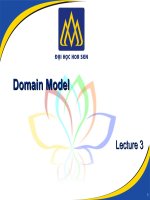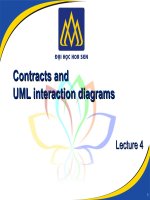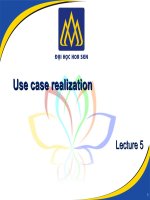Phân tích thiết kế hướng đối tượng (phân 3) ppsx
Bạn đang xem bản rút gọn của tài liệu. Xem và tải ngay bản đầy đủ của tài liệu tại đây (949.41 KB, 50 trang )
3 Case study: flight booking system
82
3.3 Step 3 – Modelling sentences 8 and 9
Let’s now consider the stopovers, i.e. sentences 8 and 9.
8. A flight may involve stopovers in airports.
9. A stopover has an arrival time and a departure time.
Every stopover has two properties according to sentence 9: arrival time and
departure time. According to sentence 8, it is also in connection with flights and
airports, which are themselves objects. It is therefore natural to make a class of it
for itself.
However, sentence 8 is also imprecise: can a stopover belong to several flights,
and what are the multiplicities between Stopover and Airport? Moreover, the
diagram still does not indicate the multiplicities on the Flight side with Airport.
Figure 3.12 Completed modelling of sentence 10
Figure 3.13 Preliminary modelling of sentences 8 and 9
Airport
servers
City
0 *
1 *
Flight
departureDate
departureTime
arrivalDate
arrivalTime
openBooking()
closeBooking()
involves
Stopover
arrivalTime
departureTime
0 *
?
departure
arrival
Airport
name
1
1
?
?
?
?
11_Chapter_03_Roques_NEW.fm Page 82 Friday, November 28, 2003 1:19 PM
3.3 Step 3 – Modelling sentences 8 and 9
83
** 3.4 Complete the multiplicities of the associations.
Answer 3.4
Answer 3.4Answer 3.4
Answer 3.4
According to sentence 8, a flight can involve stopovers in airports. This wording is
ambiguous, and is worth thinking about a little, maybe by resorting to the advice
of a domain expert.
We can start by adding the multiplicities between Stopover and Airport, which
appears to be easy. It is obvious that a stopover takes place in one and only one
airport, and that an airport can be used for several stopovers. In the same way, an
airport can be used as a departure or arrival airport for several flights.
We might also think that a stopover belongs to one flight and only one, but is
this really certain? After consulting with the domain expert, we obtained a counter-
example in the form of the following object diagram.
29
Figure 3.14 Object diagram illustrating sentence 8
29. Toulouse and Bordeaux are the main cities of the South-West of France, with Blagnac and Merignac
being their airports, respectively, Palma and Minorca are touristy Spanish resorts
ToulouseMinorca : Flight
Palma : Stopover
BordeauxMinorca : Flight
arrival
arrival
Minorca : Airport
departure
departure
Merignac : Airport
Palma : Airport
Bordeaux : Stopover
Blagnac : Airport
11_Chapter_03_Roques_NEW.fm Page 83 Friday, November 28, 2003 1:19 PM
3 Case study: flight booking system
84
A stopover can therefore belong to two different flights, particularly when these
flights overlap. Note how effective it is to resort to the object diagram to give an
example, or even a counter-example, which enables a tricky aspect of a class
diagram to be refined.
To complete the diagram of sentences 8 and 9, all we have to do is add two pieces
of information:
• the association between Flight and Stopover is an aggregation (open diamond),
as it corresponds to a containment relationship. But it cannot be a composition
(filled diamond), as it can be shared out;
• the stopovers are ordered with regard to flight, so we can add the standard UML
coinstraint {ordered} on the side of the Stopover class.
In the previous solution, the Stopover class acts as a go-between for the Flight and
Airport classes. It has little meaning by itself, and consequently, this makes us think
of another solution concerning it
*** 3.5 Propose a more sophisticated solution for the modelling of stopovers.
Figure 3.15 Complete modelling of sentences 8 and 9
Flight
departureDate
departureTime
arrivalDate
arrivalTime
openBooking()
closeBooking()
{ordered}
Stopover
arrivalTime
departureTime
takes place in
arrival
departure
Airport
name
1
1
0 *
0 *
1 *
0 *
0 *
1
11_Chapter_03_Roques_NEW.fm Page 84 Friday, November 28, 2003 1:19 PM
3.3 Step 3 – Modelling sentences 8 and 9
85
Answer 3.5
Answer 3.5Answer 3.5
Answer 3.5
In view of the preceding diagram, it appears that the Stopover class comprises little
of its own information; it is strongly linked with Airport (multiplicity 1) and does
not exist by itself, but only as part of a Flight.
An initial idea consists in regarding Stopover as a specialisation of Airport.
This is a very attractive solution, as the stopover automatically retrieves the name
of the airport by inheritance and adds the departure and arrival times by
specialisation.
Figure 3.16 Modelling with inheritance of sentences 8 and 9
Figure 3.17 More sophisticated modelling of sentences 8 and 9
Flight
departureDate
departureTime
arrivalDate
arrivalTime
openBooking()
closeBooking()
departure
arrival
Airport
name
{ordered}
Stopover
departureTime
arrivalTime
0 *
0 *
1
1
0 *
0 *
Flight
departureDate
departureTime
arrivalDate
arrivalTime
openBooking()
closeBooking()
StopoverInfo
departureTime
arrivalTime
departure
arrival
stopover
{ordered}
Airport
name
0 *
0 *
0 *
1
0 *
1
11_Chapter_03_Roques_NEW.fm Page 85 Friday, November 28, 2003 1:19 PM
3 Case study: flight booking system
86
Yet, we cannot recommend that you use this solution (Figure 3.16): can we really
say that a stopover is a type of airport; can we guarantee that the Stopover class is
100% in accordance with the specifications of its superclass? Does a stopover serve
cities, can a stopover act as a point of departure or arrival for a flight? If we add the
open and close operations to the Airport class, will they apply to Stopover? In actual
fact, it does not concern an interface inheritance, but much rather a facility, of
which an unscrupulous designer could make use in order to retrieve automatically
the name attribute of the Airport class, together with its future access methods. This
use of inheritance is called an implementation inheritance and furthermore, it is
becoming increasingly advised against. Besides, if, one day, we want to specialise –
in the business sense – airports into international and regional airports, for
example, we will have to manage a multiple inheritance immediately.
Instead, why not consider this notion of stopover as a third role played by an
airport with regard to a flight? The arrivalTime and departureTime attributes then
become association attributes, as shown on Figure 3.17. The Stopover class then
disappears as such, and finds itself replaced by an association class, StopoverInfo. We
will notice the homogeneousness of the multiplicities to the side of the Flight class.
3.4 Step 4 – Modelling sentences 3, 4 and 5
We can now tackle the modelling process of booking.
Let’s reread sentences 3 to 5, which relate to it directly.
3. A customer can book one or more flights and for different passengers.
4. A booking concerns a single flight and a single passenger.
5. A booking can be cancelled or confirmed.
A preliminary question springs to mind immediately.
* 3.6 Do we really have to make a distinction between the concepts of customer
and passenger?
Answer 3.6
Answer 3.6Answer 3.6
Answer 3.6
At first sight, this distinction can seem superfluous, but in fact, it is absolutely
necessary! Let’s take the case of business trips: the customer is often the employer
of the person who travels for his or her job. This person then plays the role of
passenger and appreciates that he or she does not need to pay the amount of his or
her ticket in advance. The concept of customer is fundamental for invoicing and
11_Chapter_03_Roques_NEW.fm Page 86 Friday, November 28, 2003 1:19 PM
3.4 Step 4 – Modelling sentences 3, 4 and 5
87
accounting matters, whereas the concept of passenger is more useful for aspects
linked to the flight itself (boarding, etc.).
]
According to sentence 4, a booking concerns a single flight and a single passenger.
We can model this straight away by applying two associations.
As for sentence 5, it is conveyed simply by adding two operations in the Booking
class, following the model of sentence 2.
Nevertheless, be aware that a more concise solution is possible, namely considering
the passenger as a simple attribute of Booking. The main drawback concerns the
management of information on passengers. Indeed, it is very likely that we need to
manage the passenger’s details (address, telephone number, e-mail address, etc.),
even a frequent flyer card, which does not easily allow for the simplistic solution
shown on the figure below.
Figure 3.18 Direct modelling of sentences 4 and 5
Figure 3.19 Simplistic modelling of sentences 4 and 5
Booking
cancel()
confirm()
concerns
concerns
Passenger
Flight
departureDate
departureTime
arrivalDate
arrivalTime
openBooking()
closeBooking()
1
1
Booking
passengerName
cancel()
confirm()
concerns
Flight
departureDate
departureTime
arrivalDate
arrivalTime
openBooking()
closeBooking()
1
11_Chapter_03_Roques_NEW.fm Page 87 Friday, November 28, 2003 1:19 PM
3 Case study: flight booking system
88
We will therefore keep the first approach, which makes Passenger a separate class.
Let’s continue with our modelling process of booking. Sentence 3 is a little more
tricky because of its over-complicated wording.
** 3.7 Model sentence 3 and complete the multiplicities of the preceding
associations.
Answer 3.7
Answer 3.7Answer 3.7
Answer 3.7
The beginning of sentence 3 can be confusing due to the direct relationship that it
seems to imply between customer and flight. In fact, the verb “to book” masks the
concept of booking that is already identified. When modelling sentence 4, we saw
that a booking concerns a single flight. The beginning of sentence 3 can therefore
be re-worded more simply: a customer can make several bookings (with each one
concerning a flight). This is conveyed directly by the following diagram.
We are going to complete the diagram by first of all adding the two missing
multiplicities. It is clear that a booking has been made by one and only one
customer, and that the same flight can be affected by zero or more bookings. Next,
let’s add the Passenger class and complete the multiplicities. How many bookings
can the same passenger have? At first sight, at least one, otherwise he or she is not
a passenger. We are, in fact, managing bookings, not the flight itself. We therefore
need to consider persistent instances of passengers, even if they do not all have a
booking at present. Once again, this is a question from a modelling standpoint! For
the application that manages boarding of passengers, a passenger has one and only
one booking, but here it is necessary to anticipate “0 *”.
Figure 3.20 Beginning of modelling of sentence 3
Customer
has made
Booking
cancel()
confirm()
concerns
Flight
1
0 *
11_Chapter_03_Roques_NEW.fm Page 88 Friday, November 28, 2003 1:19 PM
3.5 Step 5 – Adding attributes, constraints and qualifiers
89
Note the use of the direction triangle to indicate which way to read the association
name.
3.5 Step 5 – Adding attributes, constraints and
qualifiers
The model that we obtain through modelling the 10 sentences of the problem
statement currently resembles the diagram in the figure shown below.
Figure 3.21 Complete modelling of sentences 4 and 5
Figure 3.22 Preliminary modelling of case study 3
Customer
has made
Booking
cancel()
confirm()
concerns
concerns
Flight
Passenger
1
0 *
0 *
0 *
1
1
Airport
name
City
servers
stopover
0 * {ordered}
arrival
departure
AirlineCompany
offers
Flight
departureDate
departureTime
arrivalDate
arrivalTime
openBooking()
closeBooking()
StopoverInfo
departureTime
arrivalTime
Passenger
concerns
concerns
cancel()
confirm()
Booking
has made
Customer
1
1
0 *
0 *
0 *
0 *
1 *
1 *
1 *
0 *
0 *
0 *
1
1
1
11_Chapter_03_Roques_NEW.fm Page 89 Friday, November 28, 2003 1:19 PM
3 Case study: flight booking system
90
Some classes do not have any attribute, which is rather a bad sign for an analysis
model representing domain concepts. The reason for this is simply because we
have only identified the attributes that arose directly from the sentences of the
problem statement. For sure, there are some missing…
* 3.8 Add the domain attributes that you consider to be essential.
Answer 3.8
Answer 3.8Answer 3.8
Answer 3.8
For each of the classes, we will list the essential attributes below.
Be careful! We do not need to list references to other classes in the attributes: this
is the very goal of identifying associations.
Airport:
•name
Customer:
•surname
•forename
•address
•telNum
•faxNum
AirlineCompany:
•name
StopoverInfo
• departureTime
• arrivalTime
Passenger:
•surname
•forename
11_Chapter_03_Roques_NEW.fm Page 90 Friday, November 28, 2003 1:19 PM
3.5 Step 5 – Adding attributes, constraints and qualifiers
91
Booking:
•date
•number
City:
•name
Flight:
•number
• departureDate
• departureTime
• arrivalDate
• arrivalTime
Note that we are using here the naming conventions that are recommended by the
original developers of UML. These conventions are not mandatory but prove useful
when your domain model is used afterwards at the design level.
Naming Conventions in UML
Naming Conventions in UMLNaming Conventions in UML
Naming Conventions in UML
Typically, you capitalise the first letter of every word in an attribute name except the
first letter (unlike the names of classes, which systematically start with an upper
case letter).
The same conventions apply to the notation of association roles, as well to
operations.
** 3.9 Complete the model with some relevant derived attributes.
Answer 3.9
Answer 3.9Answer 3.9
Answer 3.9
A derived attribute is a property, which is considered interesting for the analyst, but
which is redundant as its value can be computed from other elements available in
the model. It is shown for clarity even though it adds no semantic information.
A good example of this is provided by the notion of length of a flight. It is obvious
that this information is important: the customer will certainly want to know the
11_Chapter_03_Roques_NEW.fm Page 91 Friday, November 28, 2003 1:19 PM
3 Case study: flight booking system
92
length of his or her flight without having to calculate it him or herself! The
information system must be capable of managing this notion. As it happens, the
information which is necessary for this is already available in the model thanks to
the existing attributes relating to the departure and arrival dates and times. This is
indeed derived information. The same reasoning applies for the length of each
stopover.
The diagram shown below summarises the new state of our model with all the
attributes.
Derived attribute in design
Derived attribute in designDerived attribute in design
Derived attribute in design
Derived attributes allow the analyst not to make an overly premature decision with
regard to design. However, as this concept does not exist in object-oriented
programming languages, the designer will be led to choose between several
solutions:
• Keep a plain attribute in design, which will have its access methods (get and set)
as do the other attributes: you must not forget to activate the update process of
the attribute as soon as an item of information is modified, on which it depends;
• Do not store the redundant value, but calculate it on request using a public
method.
Figure 3.23 Addition of business and derived attributes
Airport
name
servers
stopover
0 * {ordered}
arrival
departure
offers
concerns
concerns
has made
1
1
0 *
0 *
0 *
0 *
1 *
1 *
1 *
0 *
0 *
0 *
1
1
1
City
name
AirlineCompany
name
Flight
number
departureDate
departureTime
arrivalDate
arrivalTime
/ length
openBooking()
closeBooking()
StopoverInfo
departureTime
arrivalTime
/ length
Customer
surname
forename
address
telNum
faxNum
Booking
cancel()
confirm()
date
number
Passenger
surname
forename
11_Chapter_03_Roques_NEW.fm Page 92 Friday, November 28, 2003 1:19 PM
3.5 Step 5 – Adding attributes, constraints and qualifiers
93
The second solution is desirable if the request frequency is low and the algorithm
to calculate is simple. On the other hand, the first approach is necessary if the value
of the derived attribute is required to be available on a permanent basis, or if the
calculation is very complex and expensive. As always, the choice of the designer is
a matter of compromise…
*** 3.10 Refine the diagram even more by adding constraints and a qualified
association.
Answer 3.10
Answer 3.10Answer 3.10
Answer 3.10
We may well find a large number of constraints on a class diagram. It is better to
make an exhaustive list of them in the text that accompanies the model, and then
choose the most important ones with care, which we will then be able to insert in
the diagram. Otherwise, we run the risk of overloading the diagram and making it
difficult to follow.
On our example, we decided to show the strongest constraints between the
attributes. They correspond to business rules that will have to be implemented in
the final information system.
We have also emphasised the fact that a booking concerns a single flight and a
single customer, and is irreversible into the bargain. To change flight or customer,
the booking in question must be cancelled and a new one created. This can be
conveyed in UML by constraints {frozen}
30
on the association roles concerned.
Finally, we have converted the number attribute of the Flight class into a qualifier
of the offers association between the AirlineCompany and Flight classes. Indeed, each
flight is identified uniquely by a number appropriate for the company. Note how
Example of conversion of a derived attribute into a design method
30. Even though {frozen} seems to have disappeared from the standard constraints with UML 2.0, you
can still use this interesting convention.
Analysis
Design
StopoverInfo
departureTime
arrivalTime
/ length
StopoverInfo
- departureTime
- arrivalTime
+ getLength
11_Chapter_03_Roques_NEW.fm Page 93 Friday, November 28, 2003 1:19 PM
3 Case study: flight booking system
94
the addition of the qualifier reduces the multiplicity to the side of the Flight class.
The figure presented below shows the completed class diagram.
3.6 Step 6 – Using analysis patterns
There’s room for even more improvement in our model!
To this end, let’s go back to the elements that concern the Flight class, as
represented on the following figure. Do you not think that the Flight class has many
different responsibilities, considering all its attributes and associations? It violates
a strong principle of object-oriented design, which some authors call high
cohesion.
31
Figure 3.24 Addition of the constraints and qualifier
31. One of the most important responsibility assignment patterns (GRASP) according to C. Larman.
Refer once again to Applying UML and Patterns (2nd Edition), Prentice Hall, 2001.
Airport
name
serves
stopover
0 * {ordered}
arrival
departure
offers
concerns
concerns
1
1
0 *
0 *
0 *
0 *
1 *
1 *
0 1
0 *
0 *
0 *
1
1
City
name
AirlineCompany
name
Flight
departureDate
departureTime
arrivalDate
arrivalTime
/ length
openBooking()
closeBooking()
StopoverInfo
departureTime
arrivalTime
/ length
Customer
surname
forename
address
telNum
faxNum
Booking
cancel()
confirm()
date
number
Passenger
surname
forename
Qualifier
number
{length =
arrivalTime - departureTime}
Constraints
{frozen}
{frozen}
{booking.date
<= flight.departureDate}
has made
1
11_Chapter_03_Roques_NEW.fm Page 94 Friday, November 28, 2003 1:19 PM
3.6 Step 6 – Using analysis patterns
95
**** 3.11 Propose a more sophisticated solution for modelling the flights.
Answer 3.11
Answer 3.11Answer 3.11
Answer 3.11
The Flight class from the preceding diagram has two different types of respons-
ibilities:
• The first concerns all information that can be found in the schedules of airline
companies: yes, there is indeed a nonstop flight from Toulouse-Paris Orly every
Monday morning at 7h10, offered by Air France… This is a generic flight, which
is available every week, or near enough every week.
• The second gathers information relating to bookings. You are not booking a
Toulouse-Paris Orly flight on Monday morning, but rather the Toulouse-Paris
Orly flight on 25 January 2004!
Figure 3.25 Detail of the model concerning the Flight class
Airport
name
stopover
0 * {ordered}
arrival
departure
offers
concerns
1
1
0 *
0 *
0 *
1 *
0 1
0 *
AirlineCompany
name
Flight
departureDate
departureTime
arrivalDate
arrivalTime
/ length
openBooking()
closeBooking()
StopoverInfo
departureTime
arrivalTime
/ length
Booking
cancel()
confirm()
date
number
number
{frozen}
1
11_Chapter_03_Roques_NEW.fm Page 95 Friday, November 28, 2003 1:19 PM
3 Case study: flight booking system
96
Looking at the preceding figure, we can see a type of instantiation relationship
between a GenericFlight class limited to the first type of responsibilities, and a Flight
class that gathers the responsibilities of the second type.
Indeed, a generic flight describes once and for all properties that will be identical
for numerous real flights.
Likewise, let’s suppose that a company cancels all its subsequent weekend flights
departing from airport X, as these are unavailable until further notice due to
considerable maintenance work being carried out every Saturday and Sunday. In
our first solution, this signifies that we are going to get rid of all corresponding
instances of the Flight class. At the end of the maintenance period of airport X, we
will have to recreate the instances of Flight with their valued attributes and their
links from scratch. If we take a GenericFlight into account, however, the values of the
attributes and the links of the flights leaving from X are not lost; there will simply
not be a corresponding, real instance of Flight for three months.
To update the model, all you have to do is:
• distribute the attributes, operations and associations of the former Flight class
among the two classes of GenericFlight and Flight;
• add an association, “1-*” describes, between GenericFlight and Flight.
Moreover, we have added two attributes in the GenericFlight class to indicate the
weekday of the flight, and the time of year when it is available. An additional
constraint links the values of the departureDate attributes of the Flight class and of
the GenericFlight class.
Figure 3.26 Separation of the responsibilities of the Flight class
Airport
name
stopover
0 * {ordered}
arrival
departure
offers
concerns
1
1
0 *
0 *
0 *
1 *
0 1
0 *
AirlineCompany
name
Flight
departureDate
departureTime
arrivalDate
arrivalTime
/ length
openBooking()
closeBooking()
StopoverInfo
departureTime
arrivalTime
/ length
Booking
cancel()
confirm()
date
number
number
{frozen}
1
Generic flight Booking
11_Chapter_03_Roques_NEW.fm Page 96 Friday, November 28, 2003 1:19 PM
3.6 Step 6 – Using analysis patterns
97
validityPeriod with a non-primitive data type
validityPeriod with a non-primitive data typevalidityPeriod with a non-primitive data type
validityPeriod with a non-primitive data type
The validityPeriod is not a simple attribute: we can ask it for its beginning, end,
length, etc. A solution has been put forward by M. Fowler
32
: create a class called
TimePeriod (as for Date previously), and then use it to specify the type of the
attribute.
32. Analysis Patterns: Reusable Object Models, M. Fowler, Addison-Wesley, 1997.
Modelling of the “non-primitive” type, TimePeriod
Figure 3.27 Distribution of responsibilities among GenericFlight and Flight
TimePeriod
DateTimeStamp
Date
Time
start
end
1
1
1
1
1
1
1
1
Airport
name
stopover
0 * {ordered}
arrival
departure
defines
describes
1
1
0 *
0 *
0 *
1 *
0 1
0 *
0 *
1
AirlineCompany
name
<<metaclass>>
GenericFlight
day
departureTime
arrivalTime
/ length
validityPeriod
StopoverInfo
departureTime
arrivalTime
/ length
Flight
openBooking()
closeBooking()
departure Date
arrivalDate
number
{frozen}
concerns
1
flight.departureDate must be included
in genericFlight.validityPeriod
{addOnly}
charterer
offers
{frozen}
Booking
cancel()
confirm()
date
number
0 *
11_Chapter_03_Roques_NEW.fm Page 97 Friday, November 28, 2003 1:19 PM
3 Case study: flight booking system
98
Finally, we must see to it that sentence 2 is respected. A flight is open or closed to
booking by order of the company. Here, we are dealing with the dated flight and
not the generic flight. It is the same for a possible cancellation… We must therefore
add a direct association between Flight and AirlineCompany, which would allow the
interaction described in Figure 3.5, whilst retaining the qualified association
between GenericFlight and AirlineCompany.
Figure 3.26 is therefore altered, as shown on Figure 3.27. Each of the two classes
– Flight and GenericFlight – has found back high cohesion.
Metaclass pattern
Metaclass patternMetaclass pattern
Metaclass pattern
The separation of responsibilities which was carried out previously can be
generalised in the form of an “analysis pattern”, which can be reused in other
contexts.
We identify an XX class,which has too many responsibilities, some of which are
not specific to each instance. We add a TypeXX class, we distribute the properties
among the two classes and we link them by a “* - 1” association. The TypeXX class
is described as a “metaclass”, as is GenericFlight on the figure below, as it contains
information that describes the XX class.
Note that the limited navigation from XX to TypeXX is not mandatory but is very
frequent (at least in design).
3.7 Step 7 – Structuring into packages
Our domain model is now almost finished. To make using it even easier and in
order to prepare the object-oriented design activity, we will structure it into
packages.
Reusable generic diagram
Metaclass
XX
att1
att2
TypeXX
att3
att4
1
*
11_Chapter_03_Roques_NEW.fm Page 98 Friday, November 28, 2003 1:19 PM
3.7 Step 7 – Structuring into packages
99
Structuring into packages
Structuring into packagesStructuring into packages
Structuring into packages
Structuring a domain model is a tricky procedure. It must rely on two basic
principles: coherence and independence.
The first principle entails grouping the classes that are similar from a semantic
point of view. To do this, the following coherence criteria must be met:
• objective: the classes must return services of the same nature to users;
• stability: we isolate the classes that are truly stable from those that will most
probably develop in the course of the project, or even subsequently. Notably, we
distinguish business classes from application classes;
• lifetime of objects: this criterion enables classes to be distinguished, whose
objects have very different life spans.
The second principle consists in reinforcing this initial division by endeavouring to
minimise the dependencies between packages.
Figure 3.28 Domain model before structuring
Airport
name
serves
City
name
stopover
0 * {ordered}
arrival
departure
AirlineCompany
name
number
defines
<<metaclass>>
GenericFlight
day
departureTime
arrivalTime
/ length
validityPeriod
StopoverInfo
departureTime
arrivalTime
/ length
Customer
surname
forename
address
telNum
faxNum
{frozen}
has made
{frozen}
describes
charterer
offers
Flight
departureDate
arrivalDate
openBooking()
closeBooking()
{frozen}
concerns
Booking
date
number
cancel()
confirm()
concerns
Passenger
surname
forename
{addOnly}
1
1
0 *
0 *
0 *
0 *
1 *
1
0 1
1 *
0 *
0 *
1
0 *
1
0 *
1
0 *
1
11_Chapter_03_Roques_NEW.fm Page 99 Friday, November 28, 2003 1:19 PM
3 Case study: flight booking system
100
** 3.12 Propose a division of the domain model into two packages.
Answer 3.12
Answer 3.12Answer 3.12
Answer 3.12
According to the aforementioned criteria, we can offer an initial division into two
packages:
• the first will concern the definition of flights, very stable in time, especially the
section specific to GenericFlight;
• the second will deal with bookings, together with all their associations.
Each package contains a set of classes that are tightly linked, but the classes of the
two packages are almost independent. This first division is indicated by the line that
acts as a partition in the diagram shown below.
Figure 3.29 Division of the model into two independent sections
Airport
name
serves
City
name
stopover
0 * {ordered}
arrival
departure
AirlineCompany
name
number
defines
<<metaclass>>
GenericFlight
day
departureTime
arrivalTime
/ length
validityPeriod
StopoverInfo
departureTime
arrivalTime
/ length
Customer
surname
forename
address
telNum
faxNum
{frozen}
has made
{frozen}
describes
charterer
offers
Flight
departureDate
arrivalDate
openBooking()
closeBooking()
{frozen}
concerns
Booking
date
number
cancel()
confirm()
concerns
Passenger
surname
forename
{addOnly}
1
1
0 *
0 *
0 *
0 *
1 *
1
0 1
1 *
0 *
0 *
1
0 *
1
0 *
1
0 *
1
11_Chapter_03_Roques_NEW.fm Page 100 Friday, November 28, 2003 1:19 PM
3.7 Step 7 – Structuring into packages
101
There is, however, another solution that consists in positioning the Flight class in
the same package as the Booking class, as illustrated on the following diagram. The
favoured criterion in this second division is the lifetime of the objects, with the
instantiated flights being closer to bookings than to generic flights.
**** 3.13 Find a solution that minimises coupling between the two packages.
Figure 3.30 Possible second division of the model
Airport
name
serves
City
name
stopover
0 * {ordered}
arrival
departure
AirlineCompany
name
number
defines
<<metaclass>>
GenericFlight
day
departureTime
arrivalTime
/ length
validityPeriod
StopoverInfo
departureTime
arrivalTime
/ length
Customer
surname
forename
address
telNum
faxNum
{frozen}
has made
{frozen}
describes
charterer
offers
Flight
departureDate
arrivalDate
openBooking()
closeBooking()
{frozen}
concerns
Booking
date
number
cancel()
confirm()
concerns
Passenger
surname
forename
{addOnly}
1
1
0 *
0 *
0 *
0 *
1 *
1
0 1
1 *
0 *
0 *
1
0 *
1
0 *
1
0 *
1
11_Chapter_03_Roques_NEW.fm Page 101 Friday, November 28, 2003 1:19 PM
3 Case study: flight booking system
102
Answer 3.13
Answer 3.13Answer 3.13
Answer 3.13
In the two previous cases, we can state that at least one association traverses the
boundary between the packages. The problem of associations traversing two
packages resides in the fact that just one of them is enough to lead to a mutual
dependency – if it is bidirectional. In fact, the object designer has to hunt down
mutual or cyclical dependencies to increase the modularity and evolutionary
capability of his or her application.
In the first solution, a single association is involved, as recalled in the diagram
below. But this association produces a mutual dependency between the two
packages all by itself.
Navigability and dependency
Navigability and dependencyNavigability and dependency
Navigability and dependency
By default, an association between two classes, A and B, enables navigation in both
directions between objects of class A and objects of class B.
However, it is possible to limit this navigation to only one of the two directions
in order to eliminate one of the two dependencies induced by the association. UML
allows us to represent this navigability explicitly by adding onto the association an
arrow that indicates the only possible direction.
In our example, we will make a choice and favour a navigation direction in order
to rule out one of the two dependencies. It is clear that knowledge of the flight
concerned is a prerequisite of a booking, whereas a flight can exist by itself,
independently of any booking.
The previous diagram can therefore be modified so that it only shows the
dependency of the Bookings package towards the Flights package.
Figure 3.31 Mutual dependency between packages
Bookings
Booking
date
number
cancel()
confirm()
concerns
{frozen}
Flights
Flight
departureDate
arrivalDate
openBooking()
closeBooking()
0 *
1
11_Chapter_03_Roques_NEW.fm Page 102 Friday, November 28, 2003 1:19 PM
3.7 Step 7 – Structuring into packages
103
Let’s now take a closer look at the second solution. This time, two associations are
traversing the packages. What can we do to reduce the navigabilities of these
associations?
It makes sense to fix one direction of navigability from Flight towards
GenericFlight: a real flight is described by one and only one generic flight to which
it must have access, whereas a generic flight can exist by itself.
Figure 3.32 Minimised coupling between the packages
Figure 3.33 Inevitable mutual dependency for the second solution
Bookings
Booking
date
number
cancel()
confirm()
concerns
{frozen}
Flights
Flight
departureDate
arrivalDate
openBooking()
closeBooking()
0 *
1
Bookings
Flight
departureDate
arrivalDate
openBooking()
closeBooking()
{addOnly}
describes
offers
charterer
{frozen}
FlightSchedule
AirlineCompany
name
<<metaclass>>
GenericFlight
day
departureTime
arrivalTime
/ length
validityPeriod
0 *
0 *
1 *
1
11_Chapter_03_Roques_NEW.fm Page 103 Friday, November 28, 2003 1:19 PM
3 Case study: flight booking system
104
Alas, for the second association, we already know that navigability is mandatory for
AirlineCompany towards Flight due to sentence 2, and which was illustrated by the
collaboration diagram in Figure 3.5.
Even if we remove the navigability of Flight towards AirlineCompany, we will end
up with two navigable associations in different directions. This is enough to impose
a mutual dependency between the packages, as demonstrated in Figure 3.33.
This study on the coupling of packages for the two proposed solutions therefore
makes the scales tip towards the first solution, which was not at all evident from the
outset.
Classes are distributed between both packages as indicated in Figure 3.34. The
Flights package can now lend itself to re-use, unlike the Bookings package.
The complete state of our model can now be synthesised by the following diagram.
Figure 3.34 Structural diagram of packages from the solution that has been retained
Bookings
+ Customer
+ Passenger
+ Booking
Flights
+ Airport
+ AirportCompany
+ StopoverInfo
+ City
+ Flight
+ GenericFlight
11_Chapter_03_Roques_NEW.fm Page 104 Friday, November 28, 2003 1:19 PM
3.8 Step 8 – Generalisation and re-use
105
3.8 Step 8 – Generalisation and re-use
After all this work on flight bookings, we would like to expand the field of the
model by offering bus trips as well – a service that carrier companies will provide.
A bus trip has a departure city and a destination city, with associated dates and
times. The journey may entail stops in cities along the way.
A customer can book one or more trips and for one or more passengers.
*** 3.14 By analogy with the previous figure, propose a domain model for booking
bus trips.
Figure 3.35 Complete model of the flight booking system
Flights
City
name
serves
Airport
name
0 * {ordered}
stopover
departure
arrival
StopoverInfo
departureTime
arrivalTime
/ length
AirlineCompany
name
number
defines
<<metaclass>>
GenericFlight
day
departureTime
arrivalTime
/ length
validityPeriod
{frozen}
describes
charterer
offers
{addOnly}
Flight
departureDate
arrivalDate
openBooking()
closeBooking()
{frozen}
concerns
Bookings
Customer
surname
forename
address
telNum
faxNum
{frozen}
has made
Booking
date
number
cancel()
confirm()
concerns
Passenger
surname
forename
1 *
0 *
1
1
0 *
0 *
0 *
1
0 1
1 *
1
0 *
0 *
1
0 *
0 *
0 *
1
1
11_Chapter_03_Roques_NEW.fm Page 105 Friday, November 28, 2003 1:19 PM
3 Case study: flight booking system
106
Answer 3.14
Answer 3.14Answer 3.14
Answer 3.14
The model is practically identical to the preceding one, including the division into
packages.
It is a little simpler for two reasons:
• the notion of airport does not have an equivalent, and the City class is directly
associated with the JourneyByBus class;
• the distinction between Flight and GenericFlight does not seem to be a
transferable notion, as trips by bus are not as regular and, moreover, are not
scheduled in advance.
33
Figure 3.36 Domain model for booking bus trips
33. This is just an assumption! If it is relevant, we can imagine having a Terminus class identical to
Airport. Then, the BusTrips package could well be identical to Flights!
BusTrips
City
name
arrival
departure
stop
0 * {ordered}
StopInfo
arrivalTime
departureTime
/ length
offers
TourOperator
name
reference
JourneyByBus
departureDate
departureTime
arrivalDate
arrivalTime
/ length
openBooking()
closeBooking()
{frozen}
concerns
BusBookings
BusBooking
date
number
cancel()
confirm()
has made
{frozen}
Customer
surname
forename
address
telNum
telFax
concerns
Passenger
surname
forename
1
1
0 *
0 *
0 *
0 *
0 *
1
1
1
0 1
1
11_Chapter_03_Roques_NEW.fm Page 106 Friday, November 28, 2003 1:19 PM









